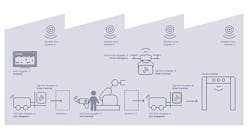Perhaps the most important insight to be gained from mobility technologies as they're adapted and applied to COVID-19 is that all the efforts and innovations made now will be useful in the long run and not just in the short term.
"Mobility used to be the idea of taking an entire HMI application with you onto the plant floor, and using it to control a process while you moved around. More recently, HMIs and physical devices like tablet PCs are more like two separate entities because the iPads are running as thin clients with industrial PCs (IPC) and other edge devices along with servers doing the data processing," says Will Aja, customer operations VP at Panacea Technologies Inc., a CSIA-member system integrator in Montgomeryville, Pa. "However, even though panel-mount HMIs ran their own software and then thin clients worked in more of a server architecture, the overall architecture was still at the plant and usually remained rigid like a tethered virtual reality (VR) display. Now, COVID-19 has left IT departments with no choice but to allow greater access by home users running thin clients at their kitchen tables just like iPads roaming freely around their plants."
"If the current pandemic happened five or 10 years ago, we'd be in even worse trouble because mobility still pretty scarce back then. Three or four years ago, we talked to users about adopting thin clients and using server-client architectures, though as high up as now, but most stuck with local HMI/SCADA systems that weren't unified by site. Many users also had the ability to go mobile, but they weren't allowed to use it.
"Plus, even before the pandemic, regulations were pushing pharmaceutical manufacturers to use thin clients that could document logins and actions by users. Now, the pandemic is enabling them to gain remote access and troubleshoot their systems from this regulatory push. This is really a case of bureaucracy to the rescue because some users, who previously got in trouble for having a Post-It note allowing access, had to move to a client-server architecture, and prepared them ready to go remote and handle the pandemic better."
Integrator transitions itself
Aja reports that Panacea itself transitioned awhile ago to thin clients running management software connected to a hybrid cloud infrastructure, which put it in a good position when the pandemic emerged. "We didn't miss a beat," says Aja. "We're approaching 100 people on staff. We shut our office on a Thursday, and everyone was up and running at home and doing their same work on Friday."
A four-page whitepaper, "Panacea’s systematic approach for operating in a safe and productive manner during COVID-19 response measures," is available here.
Aja explains that along with mobility, but separate from it, is a desire for increased automation, not to eliminate people, but to reduce iterations of software and other tasks that must be performed. Panacea's OpenBio platform is a good example of this. It's a tablet-controlled, benchtop bioreactor for laboratory operations with no physical HMI, as well as automated, sequence-driven operations, and a remote notification/alarm system. OpenBio interfaces via a tablet PC or smart phone, and can switch between available HMI, documentation and other displays. More recently, it's also using more QR codes, tablet PCs dedicated to individuals that they can use as their own HMIs, and tablet-based stations that can be sanitized.
"Previously, these things were cool and futuristic, but now they can help reduce risk," says Aja. "It's true that many recent changes have been sudden and forced on us, but they're also allowing us to make some useful leaps and bounds. This is possible because the technology they're based on existed for a long time, but they just needed a catalyst to inspire people to use them. It's like when the light curtain was invented—it was mostly used as a product detection tool until a few fingers were lost, and after that the machine-guarding aspects were essential. Likewise, virtual reality (VR) and augmented reality (AR) used to be a big gimmick because 3D views weren't useful, but they become less far-fetched when it's difficult to go into process operations areas, and operators can send in a VR unit while they're sitting in a remote room. In the same way, thin clients and servers used to be neat to have, but became crucial when users realized they could mitigate the risk of running 150 HMIs in a plant and having to stock 30 different models."
Aja reports mobility technology and planning can lighten the burden of COVID-19 situations and requirements. "If we're required to eliminate physical locating of people going into main facilities, then HMI and plant design can be revised going in to stop movement and comply with extreme social distancing," says Aja. "To stop a lot of people from walking around and reduce task iterations requires more use of Industrial Internet of Things (IIoT) solutions and joint efforts by operations technology (OT) and information technology (IT) personnel to create safer infrastructures for them. This is why we're seeing projects shifting to very IT-focused orientations. Again, these technologies are the same as before, but the priority has shifted to making sure networks and devices are redundant, fault-tolerant, safe and cyber-secure, so their applications can still collect, remotely view, and analyze data using thin clients and servers."
Aja adds that mobility can also help during the pandemic by documenting use of devices. "We're seeing requests from users who want to know who had which tablet HMI and for how long? This is for maintaining internal contact tracing and sanitization by documenting and generating reports about who interacted with who," says Aja. "Pharmaceutical tracing already tracks who's in which clean room and for how long. Now, this strategy is being applied to larger areas, facilities and buildings."
Got what's needed? Plan long-term
Because many mobility technologies are widely available, Aja recommends that users check if they already have some they aren't using before buying the latest ones being promoted. "There's a lot of ambulance chasing and posturing going on, and some people saying 'buy this and it will solve all your problems.' We ask users to consider what mobility technology they may already have in place, and first determine how they can work with what they've already got," says Aja. "Many have some form of thin clients and servers, or can easily work with their engineering team or a system integrator to add them. Of course, this requires OT and IT to work together more than before to implement mobile HMIs and the network resilience they need, which means thinking beyond cybersecurity to also address personnel requirements."
Beyond addressing immediate COVID-19 issues, Aja explains it's still important for users to fill in other gaps and plan for longer-term goals like improving safety. "Gaps in capabilities can include chunks of plants that are still using standalone HMIs, and putting QR codes on panels to help document and deliver their data to servers, or enable tablet PCs to be used instead," adds Aja. "Similar to a safety plan that addresses the most pressing issues first, we also have to deal with legacy equipment such as old PLCs that don't allow networking and remote connections. There will be a massive push for this during the pandemic and after."
Aja reports his last big tip is asking users to think beyond solving immediate COVID-19 issue, even though it's very difficult. "If we only design for problems now, then that will create additional problems in the future," says Aja. "We need to create a five-year plan about where we're at, where we want to go, and how to get there. Some organizations are very successful at this, and now they're less affected by the pandemic because three years ago, they migrated their legacy equipment, beefed up their network, and added redundancy. Consequently, when they had to move people offsite due to COVID-19, they already had what they needed to do it."
Aja adds that Panacea has seen two main types of clients and responses to COVID-19. The first previously went out of their way to make sure thin clients linked to a server weren't allowed at their facilities, made certain that plant processes and data couldn't be accessed if users weren't physically inside their building, and only allowed programming changes to be made onsite. "All of this meant they were hamstrung by the pandemic, while clients that did use thin clients and servers never missed a beat," says Aja. "No one wants to be caught on the wrong side of events like this, but COVID-19 has really shown we're not as safe as we thought, so we have to be more prepared.
"System integrators have to do the same. We tell our staff that relying on interacting with clients face-to-face and being in offices will make business suffer. However, those who can find ways interact with clients remotely or in a hybrid approach will continue to thrive."






